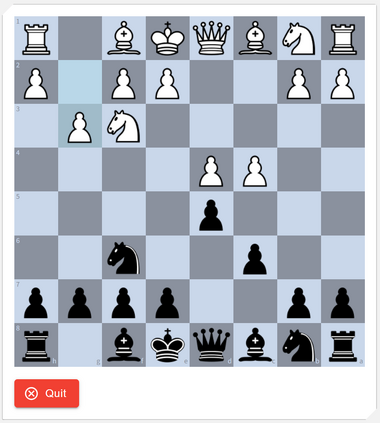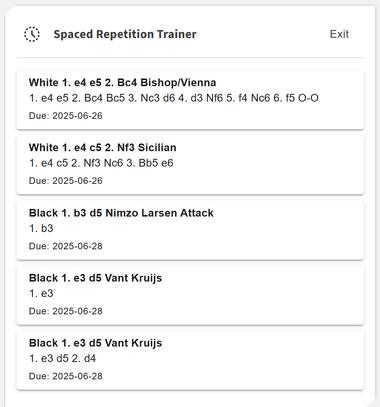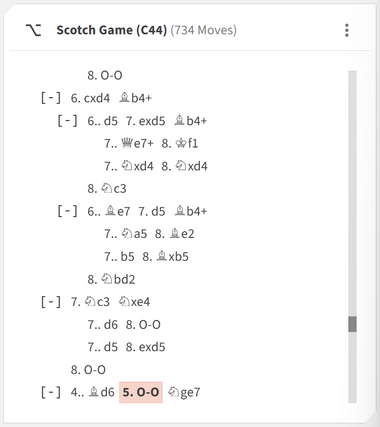Spaced Trainer: Difference between revisions
More actions
HollowLeaf (talk | contribs) Created page with "The Spaced Trainer uses spaced repetition to help you review and remember positions from your repertoire more effectively. It selects positions and reintroduces them at carefully timed intervals, ensuring you practice them just before they fade from memory. This structured approach strengthens long-term recall and makes your training both efficient and sustainable." |
HollowLeaf (talk | contribs) No edit summary |
||
| Line 1: | Line 1: | ||
The Spaced Trainer uses spaced repetition to help you review and remember positions from your repertoire more effectively. It selects positions and reintroduces them at carefully timed intervals, ensuring you practice them just before they fade from memory. This structured approach strengthens long-term recall and makes your training both efficient and sustainable. | '''Location:''' Trainer > Spaced Trainer | ||
The '''Spaced Trainer''' uses <b>spaced repetition</b> to help you review and remember positions from your repertoire more effectively. | |||
It selects positions and reintroduces them at carefully timed intervals, ensuring you practice them just before they fade from memory. | |||
This structured approach strengthens long-term recall and makes your training both efficient and sustainable. | |||
This allows you to: | |||
<ul style="list-style:none; padding-left:1.5em; margin:0;"> <li style="text-indent:-1.1em; padding-left:1.1em;"> <span style="display:inline-block; width:0.9em; text-align:center; font-weight:bold;">+</span> Reinforce key positions through scientifically timed review sessions </li> <li style="text-indent:-1.1em; padding-left:1.1em;"> <span style="display:inline-block; width:0.9em; text-align:center; font-weight:bold;">+</span> Maximize retention by revisiting moves just before they’re forgotten </li> <li style="text-indent:-1.1em; padding-left:1.1em;"> <span style="display:inline-block; width:0.9em; text-align:center; font-weight:bold;">+</span> Build strong, long-term recall of your entire repertoire through consistent daily practice </li> </ul> | |||
== What is Spaced Memory Training? == | |||
Spaced memory training (or <b>spaced repetition</b>) is a proven learning technique based on the principle that information is more easily retained when reviewed at increasing intervals over time. | |||
Rather than repeating the same material frequently in a short period, the learner revisits it just as it’s about to be forgotten — a method shown to greatly enhance long-term retention. | |||
In the context of chess, this means that instead of reviewing every move daily, the Spaced Trainer presents you with positions from your repertoire precisely when you need to refresh them. | |||
This approach minimizes wasted effort while ensuring that your understanding deepens with every review. | |||
== Controls == | |||
[[File:SpacedTrainer-Chessboard.png|thumb|380px]] | |||
[[File:SpacedTrainer-Controls.png|thumb|380px]] | |||
The '''Controls''' section determines which positions are due or overdue for review based on the <b>FSRS (Flexible Spaced Repetition System)</b> algorithm. | |||
It analyses data from both the '''[[Position_Trainer|Position Trainer]]''' and '''[[Repertoire_Trainer|Repertoire Trainer]]''', calculating when each position should next be studied. | |||
This allows you to: | |||
<ul style="list-style:none; padding-left:1.5em; margin:0;"> <li style="text-indent:-1.1em; padding-left:1.1em;"> <span style="display:inline-block; width:0.9em; text-align:center; font-weight:bold;">◦</span> <b>Filter by repertoire:</b> Focus on specific repertoires or lines by using wild card filtering on repertoire names </li> <li style="text-indent:-1.1em; padding-left:1.1em;"> <span style="display:inline-block; width:0.9em; text-align:center; font-weight:bold;">◦</span> View which positions are <b>due</b> or <b>overdue</b> for review — ideal for daily training sessions </li> <li style="text-indent:-1.1em; padding-left:1.1em;"> <span style="display:inline-block; width:0.9em; text-align:center; font-weight:bold;">◦</span> <b>Include today’s results:</b> Toggle whether to include positions you trained today for full session resets or progress tracking </li> </ul> | |||
The '''Chessboard Card''' displays the selected position, allowing you to recall and play your intended repertoire move. | |||
When in training mode, a <b>Quit</b> button is shown. | |||
When the training position is completed, you’ll see <b>Reset</b>, <b>Back</b>, and <b>Next</b> buttons, as well as <b>Flip Orientation</b>. | |||
You can also navigate using the left and right arrow keys on your keyboard. | |||
When you end the attempt, the '''Moves Card''' appears to let you review the correct line and compare it with your chosen move. | |||
== Moves Card == | |||
[[File:SpacedTrainer-MovesCard.png|thumb|380px]] | |||
The '''Moves Card''' appears once you finish a training attempt. | |||
It allows you to review the correct move sequence in detail, comparing your chosen line with your intended repertoire. | |||
This card mirrors the structure of the '''[[Weakness_Trainer|Weakness Trainer]]''' review view, including all visualization and annotation tools. | |||
<ul style="list-style:none; padding-left:1.5em; margin:0;"> <li style="text-indent:-1.1em; padding-left:1.1em;"> <span style="display:inline-block; width:0.9em; text-align:center; font-weight:bold;">◦</span> Review the correct continuation after each attempt </li> <li style="text-indent:-1.1em; padding-left:1.1em;"> <span style="display:inline-block; width:0.9em; text-align:center; font-weight:bold;">◦</span> Track long-term progress by monitoring how recall intervals lengthen over time </li> <li style="text-indent:-1.1em; padding-left:1.1em;"> <span style="display:inline-block; width:0.9em; text-align:center; font-weight:bold;">◦</span> Reinforce accurate responses through repetition and visual comparison </li> </ul> | |||
By following the timing set by the Spaced Trainer, you ensure your study sessions are both productive and scientifically optimized for memory retention. | |||
Over time, this builds deep, effortless recall across your entire repertoire. | |||
<i>'''Personal Note:''' | |||
I use the Spaced Trainer daily as part of my regular study routine. | |||
It’s an efficient and reliable way to ensure that no move in my repertoire ever fades from memory — and that my recall stays sharp even weeks or months later.</i> | |||
Revision as of 22:00, 13 October 2025
Location: Trainer > Spaced Trainer
The Spaced Trainer uses spaced repetition to help you review and remember positions from your repertoire more effectively. It selects positions and reintroduces them at carefully timed intervals, ensuring you practice them just before they fade from memory. This structured approach strengthens long-term recall and makes your training both efficient and sustainable.
This allows you to:
- + Reinforce key positions through scientifically timed review sessions
- + Maximize retention by revisiting moves just before they’re forgotten
- + Build strong, long-term recall of your entire repertoire through consistent daily practice
What is Spaced Memory Training?
Spaced memory training (or spaced repetition) is a proven learning technique based on the principle that information is more easily retained when reviewed at increasing intervals over time. Rather than repeating the same material frequently in a short period, the learner revisits it just as it’s about to be forgotten — a method shown to greatly enhance long-term retention.
In the context of chess, this means that instead of reviewing every move daily, the Spaced Trainer presents you with positions from your repertoire precisely when you need to refresh them. This approach minimizes wasted effort while ensuring that your understanding deepens with every review.
Controls


The Controls section determines which positions are due or overdue for review based on the FSRS (Flexible Spaced Repetition System) algorithm. It analyses data from both the Position Trainer and Repertoire Trainer, calculating when each position should next be studied.
This allows you to:
- ◦ Filter by repertoire: Focus on specific repertoires or lines by using wild card filtering on repertoire names
- ◦ View which positions are due or overdue for review — ideal for daily training sessions
- ◦ Include today’s results: Toggle whether to include positions you trained today for full session resets or progress tracking
The Chessboard Card displays the selected position, allowing you to recall and play your intended repertoire move.
When in training mode, a Quit button is shown.
When the training position is completed, you’ll see Reset, Back, and Next buttons, as well as Flip Orientation. You can also navigate using the left and right arrow keys on your keyboard.
When you end the attempt, the Moves Card appears to let you review the correct line and compare it with your chosen move.
Moves Card

The Moves Card appears once you finish a training attempt. It allows you to review the correct move sequence in detail, comparing your chosen line with your intended repertoire. This card mirrors the structure of the Weakness Trainer review view, including all visualization and annotation tools.
- ◦ Review the correct continuation after each attempt
- ◦ Track long-term progress by monitoring how recall intervals lengthen over time
- ◦ Reinforce accurate responses through repetition and visual comparison
By following the timing set by the Spaced Trainer, you ensure your study sessions are both productive and scientifically optimized for memory retention. Over time, this builds deep, effortless recall across your entire repertoire.
Personal Note: I use the Spaced Trainer daily as part of my regular study routine. It’s an efficient and reliable way to ensure that no move in my repertoire ever fades from memory — and that my recall stays sharp even weeks or months later.
